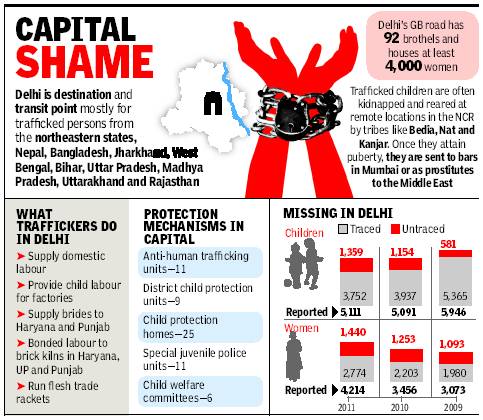Trafficking in women
This is a collection of articles archived for the excellence of their content. Readers will be able to edit existing articles and post new articles directly |
Trafficking in women
City [Delhi is a] port of call for trafficked women & children: UN report
Rackets Running Under Cover Of Parlours, Services, Agencies
Dwaipayan Ghosh TNN
The Times of India 2013/07/07
New Delhi: Delhi is a market and also a transit point for trafficked women and children brought from Nepal, Bangladesh, northeast India, West Bengal, Bihar, Madhya Pradesh and Rajasthan, claims a new study by a United Nations agency. In its countrywide assessment report published on Friday, the United Nations Office on Drugs and Crime (UNODC), which studies trafficking across 13 Indian states, claims: “The trafficking situation in Delhi has worsened as the trafficking rackets have expanded their operations in the guise of beauty parlours, friendships, spas, massage parlours and escort services. The traffickers have managed to expand operations to various satellite towns around Delhi’’.
It says a well organized system also exists to shift girls kidnapped from Delhi to Mumbai and the Middle East. “The young victims who are being kidnapped by these gangs are being kept at remote locations by some of the central Indian tribe members and once the girls attain puberty they are sent to Mumbai to work in bars and dance clubs. Many of these victims are even sent to Middle Eastern countries to be pushed into prostitution.’’
Trafficked people are exploited in various ways, the report states. Some are forced to work as domestic labour in homes, factories and brick kilns, and women are sometimes sold as brides in Haryana and Punjab.
The report prepared with help from the Union ministries of home affairs, and women and child development, and NGOs like Shakti Vahini, also discusses the illegal placement agencies that provide resident maids. “The employers are specifically looking at younger children because they come cheaper, complain less and can be exploited. There has also been an upsurge of cases of recruiting agencies taking migrant women workers to Gulf countries in the name of providing maids, and then exploiting them,’’ it says.
The report notes that while 13 of the 92 brothels on GB Road (housing 4,000 women) have been shut down, the flow of migrants from certain areas has not stopped. Recently, a joint probe by Delhi Police and Assam Police found 36 Delhi based placement agencies involved in trafficking girls to Haryana, Punjab, Mumbai and several other Metropolitan cities.
Every day, 10-12 women are sent out to the Middle East, the report says. “Mumbai is no longer a popular transit point for trafficking bar girls due to strict customs officials. It is now easier to send them via New Delhi, Chennai and sometimes Hyderabad.’’
Demand For Cheap Labour, Child Maids And Sex Workers High: UN Report
Delhi becomes a hub for traffickers
Jayashree Nandi TNN
The Times of India 2013/08/04
People are trafficked not just for sex trade but also for labour and to be employed as live-in maids. Delhi receives people from the northeast states, West Bengal, Nepal, Bangladesh and Jharkhand. Meerut and Mewat, which are close to Delhi are infamous for being “rearing points” for trafficked girls, according to anti-trafficking experts.
A recent report by the United Nations Office on Drugs and Crime (UNODC), titled ‘Current Status of Victim Service Providers and Criminal Justice Actors in India 2013’ documents how Delhi is one of the emerging hubs and transit points for trafficking. The report also highlights how girls are often kept in remote locations in the NCR, especially by people from tribes like Bedia, Nat and Kanjar, who sell them once they attain puberty.
Delhi also has many illegal placement agencies due to a high demand for live-in maids. Employers prefer young children because “they are cheaper and complain less.”
Supreme Court advocate and a principal author of the report, Ravi Kant, says “The demand for children for domestic work is very high in Delhi. Delhi is emerging as a destination and transit point and it also has a sizeable number of missing children.” Over 5,000 children went missing from Delhi in 2011. He adds that even when victims of trafficking are rescued, there are too many systemic issues which often keep them from returning home.
National Commission For Protection of Child Rights (NCPCR) member, Vinod Kumar Tikoo, links the trend to the lack of proper implementation of welfare schemes and abject poverty in some “source” states that supply labor. Two trafficked girls from Jharkhand, Jyoti Mariyam Horo (14) and Jayamani Guriya (14) couldn’t return home. Jyoti died soon after reaching Delhi. Jayamani was sent back to her village after she fell sick but died enroute due to lack of medical assistance. The NCPCR report stated how poverty stricken their families were and how the Mahatma Gandhi National Rural Employment Gurantee scheme was not being implemented. Against a guaranteed 100 days of work in a year, one of the girl’s fathers had worked for just 18 days.
Co-director of HAQ: Centre for Child Rights, Enakshi Ganguly, says people mostly associate trafficking with prostitution. “People are trafficked also for organ trade, labour, marriage and for adoption [in countries as far as the Netherlands],” she says.

